
Yes, it’s World Turtle Day, still for a little while anyway, and I did indeed get out chasing turtles – in two locations, even! Yet, I did not quite accomplish what I was hoping for.
Let’s start with the actual, bona fide turtles from today, which wasn’t too impressive. The yellow-bellied slider (Trachemys scripta scripta) above doesn’t quite count, because that was yesterday, but I liked the little bubbles still on the surface catching the morning sun. This was from the neighborhood pond, which yielded a couple more today.
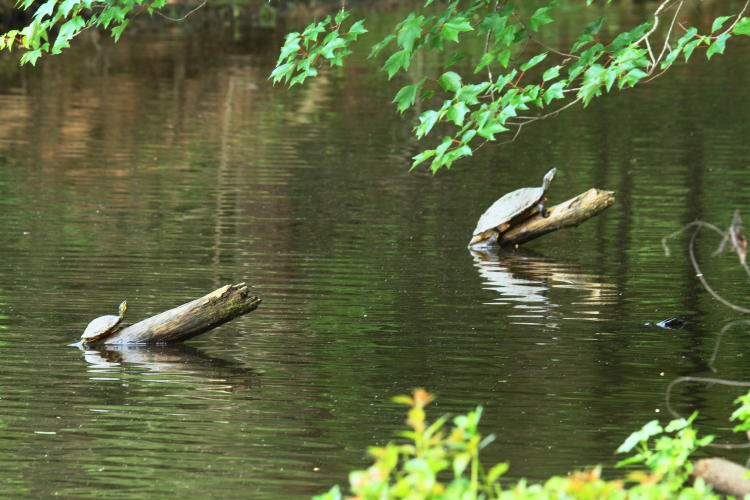
The snag in the rear is the exact same log from yesterday’s photo, but this time the occupant wasn’t anywhere near as cooperative, slipping into the water as I maneuvered to try and line up the two of them more vertically. I was still quite some distance off using the long lens, so the larger one, at least, was being especially spooky.
I had better luck with the other, probably only because it never saw me.
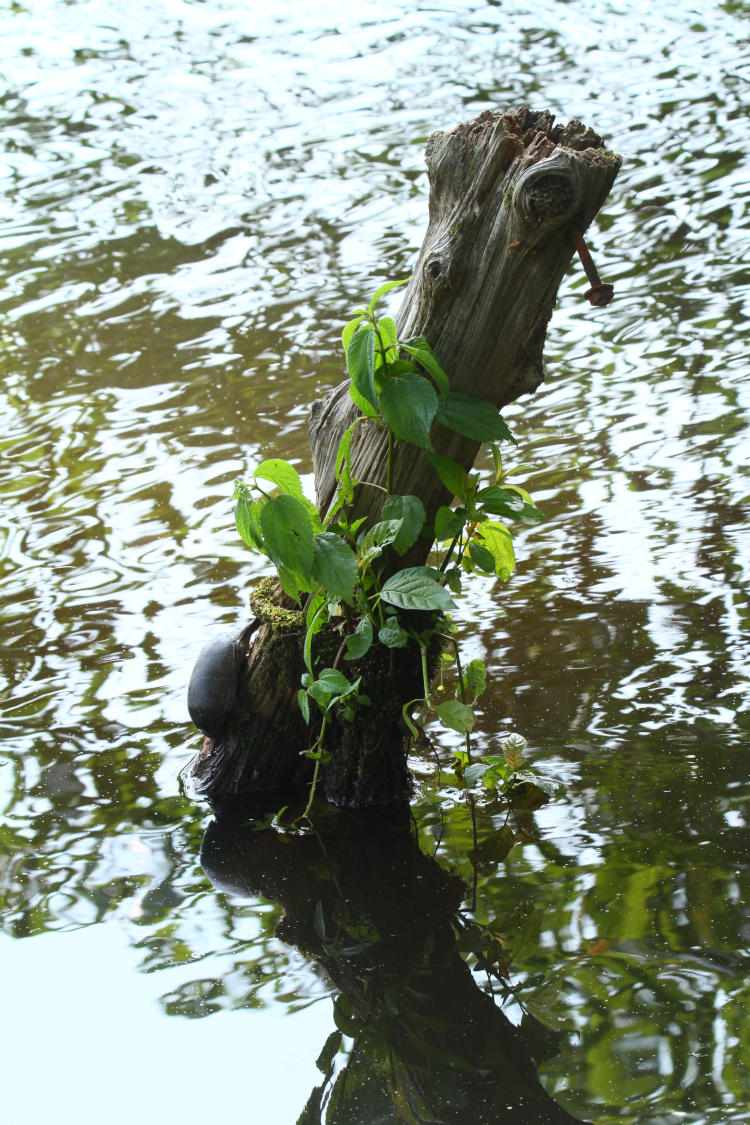
I’m going to tentatively identify this as a common musk turtle (Sternotherus odoratus,) not from any telltale markings which cannot be distinguished here, but because that’s what I tentatively identified one as before in the same location and similar circumstances, also for a holiday. Because of this, we can agree to rename the species Al’s holiday turtle (Selfabzorbt putz) to make it more appropriate. Can’t we?
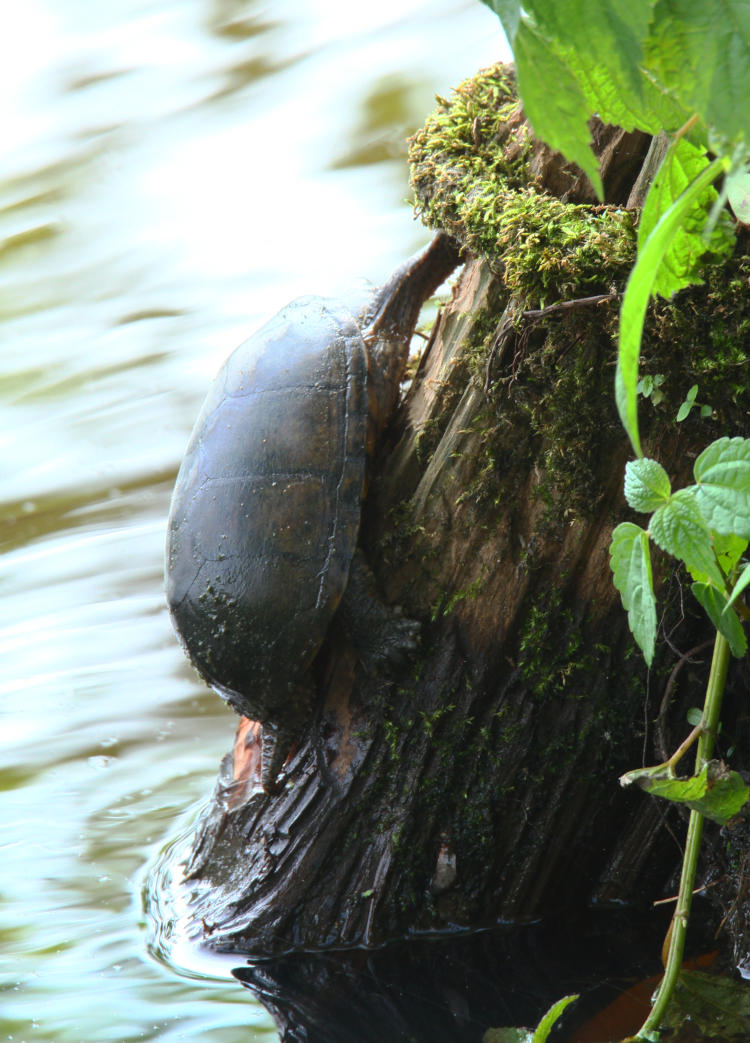
I can only speculate as to why the species likes sunning itself near-vertically, which of course won’t stop me – I’m guessing back problems. Though since the back shell (carapace) is actually their vertebrae, there’s not a lot of room for misalignment, and this one looks pretty copacetic. Probably just one of those xtreemkooldoods that does rock-climbing and longboarding and all that.
Now, I purposefully went to another location, out at my old Falls of the Neuse shooting locale, to see what I could scare up in the way of Testudines, but only got a couple of other sliders basking on rocks before my lower intestine decided that being 40-some kilometers away from home was a perfect time to begin acting up, and I cut the trip short. So everything else is from other days during the past two weeks, which I’ll do in chronological order for giggles. A laugh a minute here.
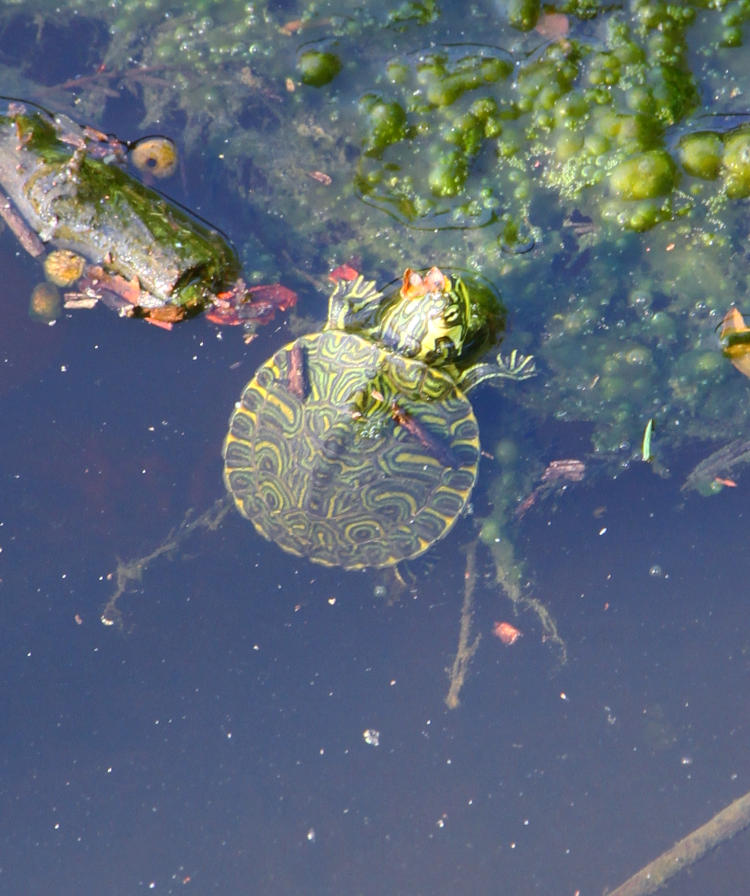
I’m not even going to try identifying this one, caught as it peeked from the water in a small pool near the North Carolina Estuarium in Washington, NC. It was no more than 45mm across the carapace, and given the conditions and location, could have been any one of several species, but very likely had hatched less than two weeks before.
That was from the trip out along Pamlico River with my brother, and the following day we were in Goose Creek State Park, seeing plenty of others, though all adults. On our way out of the park, we spotted this big ol’ common snapping turtle (Chelydra serpentina) basking on a log.
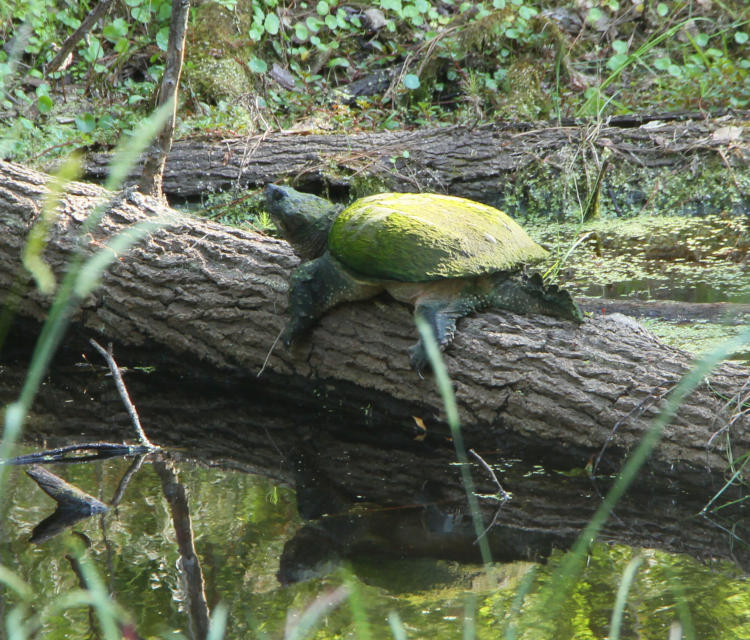
Quite a healthy specimen at roughly 30cm in carapace length, this was shot from the car window and, almost immediately after this frame, the turtle became aware of us and slipped into the water. The green carpet is algae and weeds, which helps camouflage them while lying on the bottom, but also might just be from their habits of lying on the bottom – they can hold their breath for long periods of time, and extend that neck quite a ways to poke their nostrils above the surface as needed. The shyness does make me wonder a little bit, because at this size they have few predators capable of tackling them – a coyote or wolf, maybe, and I suppose there are bears in the area, but even a fox would pass on something this size.
I’ve seen very few box turtles recently, and my brother even fewer (they’re scarce in his area,) so the following day we were happy to find two, both crossing empty roads out in severely rural coastal NC.
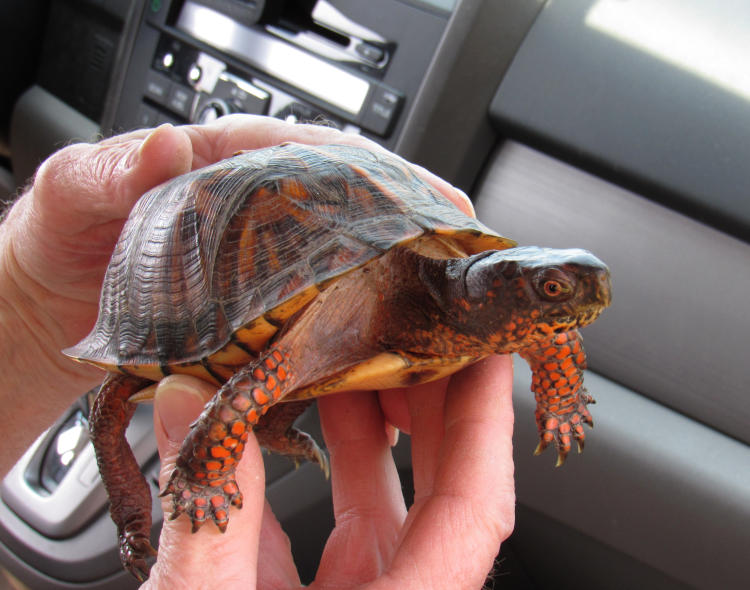
This is an eastern box turtle (Terrapene carolina carolina) and likely female, judging from the brown eyes which you’ll see better in a moment. When we stopped to get her out of the road, she reversed direction and tried hiding in the weeds, but I knew she’d try crossing the road again once we left and would get exposed to traffic again, even though it was ridiculously sparse there. So we did a few detail pics before depositing her on far side of the road in the direction that she’d been heading, whereupon I did a few more ‘natural’ frames. And trust me – she was permitted to vacate her bladder thoroughly before we brought her into the car for this shot. No worries – she was surrounded by swampland and could rehydrate within minutes.
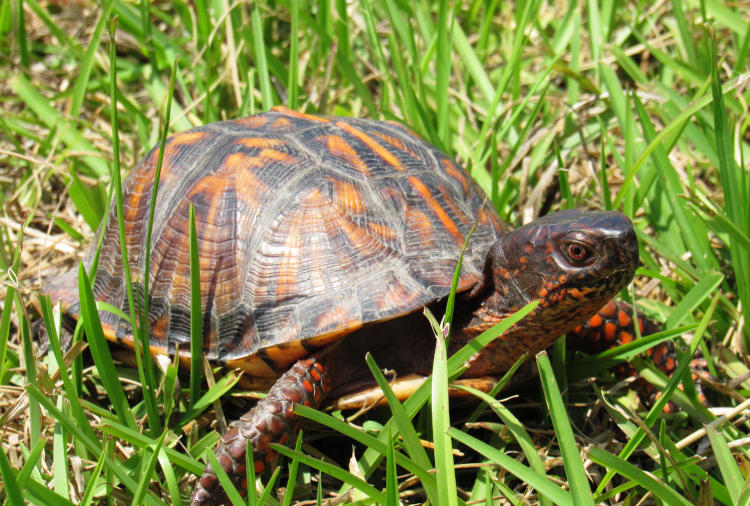
One thing captured here, intentionally, are the ridges around the ‘back scales’ (scutes,) which for box turtles are indications of their age, exactly like tree rings. Except, she had both major and minor ridges, so my estimate of the age was none too precise; if they can have minor ridges within a year’s growth, she was about 15 years old, but if each ridge indicates a full year, she was well into her thirties. I am vaguely interested in plotting the thicker and thinner ridges and determining which years were abundant and which lean for her, seeing how they compare against the droughts and so on.
By the way, I was intent on getting a full portrait angle and she was bound and determined not to let me. After a minute of us both maneuvering, I made sure she was pointed in the right direction and let her be.
Less than an hour later, we found another, again in the road and relocated to the side for these pics.
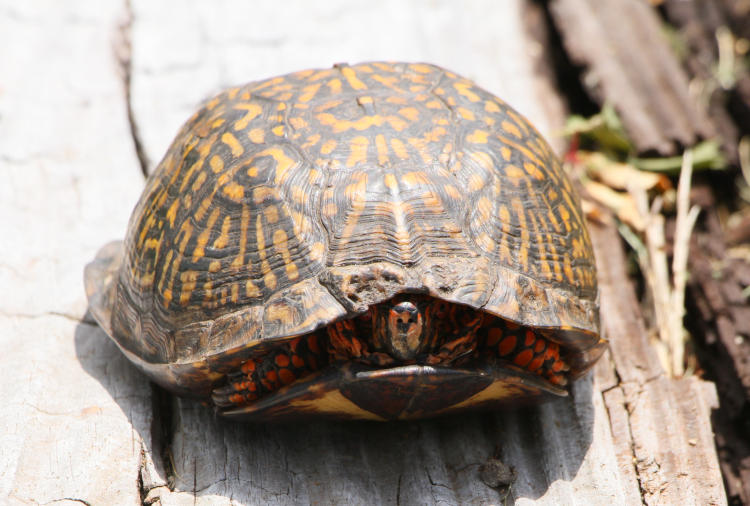
This one was far less spunky about its encounter and was inclined to close up and wait us out, and it was successful in that I got tired of waiting and settled for this bare peek. You can see old evidence of something trying to chew on its carapace near the head – such scars are pretty common among the adults, but they can seal their shells completely closed, more so than seen here, so predators are rarely successful. Let’s go in closer:
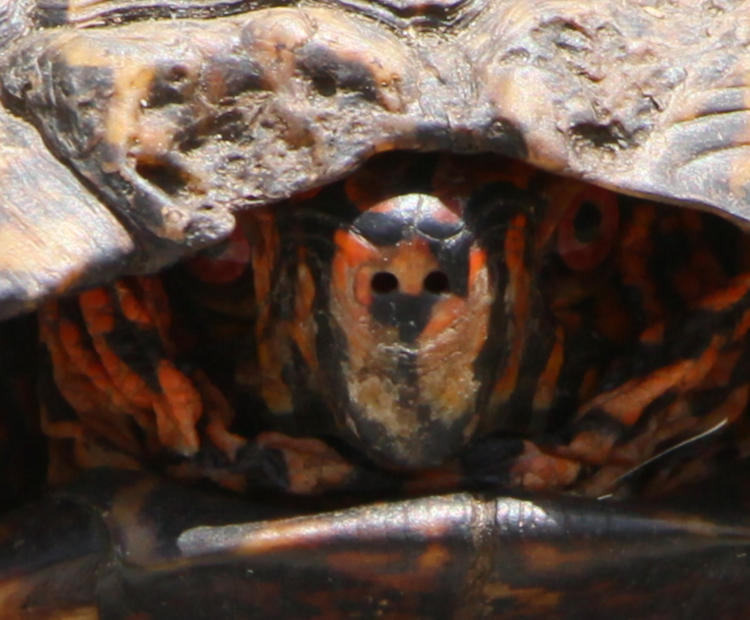
The red eyes peg this as likely a male – there’s some variation in the species, but unless it’s really crucial that you know, you can assume this is correct. Males also have a larger concave indent on their lower shells (plastrons,) but this is even more variable. Ya gotta like this perspective though.
A few days later, the same time we saw the heron scarfing down the snake (so, World Migratory Bird Day,) we spotted another tiny turtle perched on a log and trying to pass as a knot.
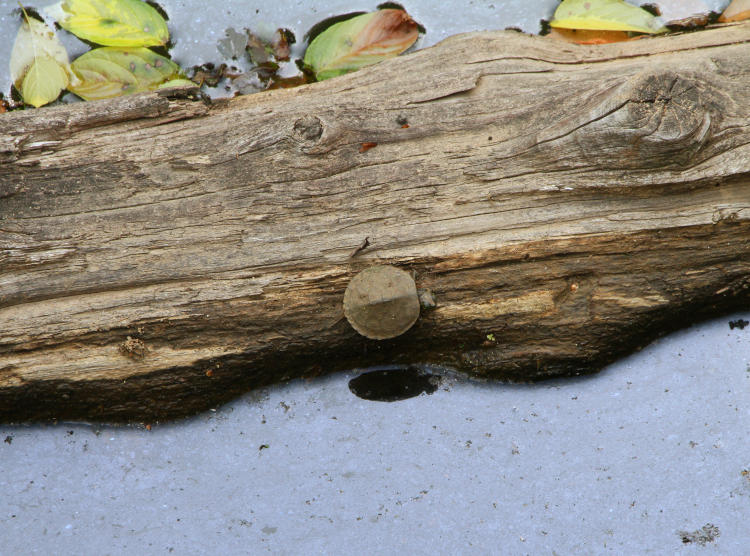
Once dry and without the sheen, the carapace color blended in extremely well, and this one was only marginally bigger than the bebby above, but distinctly different in coloration. Different species, or just a little further along after hatching and thus having developed better camouflage? Can’t say – I’m barely up on telling the adult sliders and cooters apart, so the newborns are up for grabs. But we’ll go in closer so you can do your own determination.

If forced at gunpoint to identify this one, I’d guess at yellow-bellied slider and then cower and cover my head, solely from the prevalence of the species in the area (not the cowering bit, which would be because of the gun.) Now, the plastron markings are great differentiators, but this little guy was out of reach and likely wouldn’t have waited for us to make the grab anyway.
And finally, one more from yesterday.
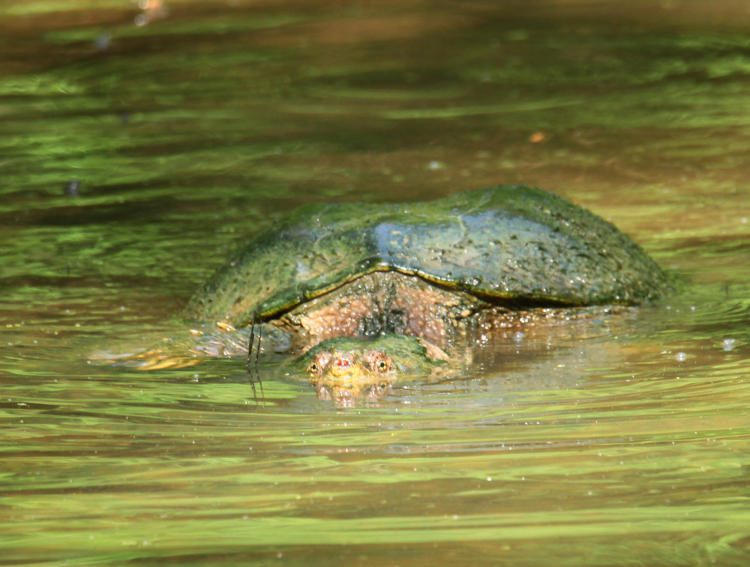
Another common snapper but with far less algae, this one was dredging its way through a shallow channel in the mud flats of the neighborhood pond, unable to submerge any more than this. It only peeked up a couple of times, mostly keeping its head down low and extended well out, probably hoping for some minnows, but this one has almost certainly added more than a couple Canada goslings to its diet.
So, a few for the holiday, some of them even taken on the holiday – I’ve fulfilled my self-imposed obligation, even posting this before midnight. w00t!




















































